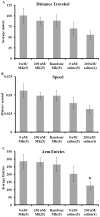Intra-accumbens injection of a dopamine aptamer abates MK-801-induced cognitive dysfunction in a model of schizophrenia
- PMID: 21779401
- PMCID: PMC3135623
- DOI: 10.1371/journal.pone.0022239
Intra-accumbens injection of a dopamine aptamer abates MK-801-induced cognitive dysfunction in a model of schizophrenia
Abstract
Systemic administration of the noncompetitive NMDA-receptor antagonist, MK-801, has been proposed to model cognitive deficits similar to those seen in patients with schizophrenia. The present work investigated the ability of a dopamine-binding DNA aptamer to regulate these MK-801-induced cognitive deficits when injected into the nucleus accumbens. Rats were trained to bar press for chocolate pellet rewards then randomly assigned to receive an intra-accumbens injection of a DNA aptamer (200 nM; n = 7), tris buffer (n = 6) or a randomized DNA oligonucleotide (n = 7). Animals were then treated systemically with MK-801 (0.1 mg/kg) and tested for their ability to extinguish their bar pressing response. Two control groups were also included that did not receive MK-801. Data revealed that injection of Tris buffer or the random oligonucleotide sequence into the nucleus accumbens prior to treatment with MK-801 did not reduce the MK-801-induced extinction deficit. Animals continued to press at a high rate over the entire course of the extinction session. Injection of the dopamine aptamer reversed this MK-801-induced elevation in lever pressing to levels as seen in rats not treated with MK-801. Tests for activity showed that the aptamer did not impair locomotor activity. Results demonstrate the in vivo utility of DNA aptamers as tools to investigate neurobiological processes in preclinical animal models of mental health disease.
Conflict of interest statement
Figures




Similar articles
-
Comparison of the MK-801-induced increase in non-rewarded appetitive responding with dopamine agonists and locomotor activity in rats.J Psychopharmacol. 2013 Sep;27(9):854-64. doi: 10.1177/0269881113492029. Epub 2013 Jun 12. J Psychopharmacol. 2013. PMID: 23761388
-
Dopamine-mediated MK-801-induced elevation in food-based extinction responding in rats and associated changes in region-specific phosphorylated ERK.Psychopharmacology (Berl). 2010 Oct;212(3):393-403. doi: 10.1007/s00213-010-1959-8. Epub 2010 Jul 23. Psychopharmacology (Berl). 2010. PMID: 20652538
-
Delayed onset of enhanced MK-801-induced motor hyperactivity after neonatal lesions of the rat ventral hippocampus.Biol Psychiatry. 2001 Mar 15;49(6):528-39. doi: 10.1016/s0006-3223(00)00968-9. Biol Psychiatry. 2001. PMID: 11257238
-
Comparison of the MK-801-induced appetitive extinction deficit with pressing for reward and associated pERK1/2 staining in prefrontal cortex and nucleus accumbens.Behav Brain Res. 2012 Mar 1;228(1):194-202. doi: 10.1016/j.bbr.2011.11.044. Epub 2011 Dec 13. Behav Brain Res. 2012. PMID: 22182675
-
The effects and mechanism of environmental enrichment on MK-801 induced cognitive impairment in rodents with schizophrenia.Front Cell Neurosci. 2022 Sep 29;16:1024649. doi: 10.3389/fncel.2022.1024649. eCollection 2022. Front Cell Neurosci. 2022. PMID: 36246525 Free PMC article. Review.
Cited by
-
Amygdala lesions reduce cataplexy in orexin knock-out mice.J Neurosci. 2013 Jun 5;33(23):9734-42. doi: 10.1523/JNEUROSCI.5632-12.2013. J Neurosci. 2013. PMID: 23739970 Free PMC article.
-
Nucleic Acid aptamers: new methods for selection, stabilization, and application in biomedical science.Biomol Ther (Seoul). 2013 Nov;21(6):423-34. doi: 10.4062/biomolther.2013.085. Biomol Ther (Seoul). 2013. PMID: 24404332 Free PMC article. Review.
-
Quantitative detection of neurotransmitter using aptamer: From diagnosis to therapeutics.J Biosci. 2020;45:44. J Biosci. 2020. PMID: 32098923 Review.
-
Challenges and opportunities for small molecule aptamer development.J Nucleic Acids. 2012;2012:748913. doi: 10.1155/2012/748913. Epub 2012 Oct 24. J Nucleic Acids. 2012. PMID: 23150810 Free PMC article.
-
Aripiprazole, A Drug that Displays Partial Agonism and Functional Selectivity.Curr Neuropharmacol. 2017 Nov 14;15(8):1192-1207. doi: 10.2174/1570159X15666170413115754. Curr Neuropharmacol. 2017. PMID: 28412910 Free PMC article.
References
-
- Linden DE. The working memory networks of the human brain. Neuroscientist. 2007;13:257–267. - PubMed
-
- Ragozzino ME. The contribution of the medial prefrontal cortex, orbitofrontal cortex, and dorsomedial striatum to behavioral flexibility. Ann N Y Acad Sci. 2007;1121:355–375. - PubMed
-
- Waford RN, Lewine R. Is perseveration uniquely characteristic of schizophrenia? Schizophr Res. 2010;118:128–133. - PubMed
-
- Neill JC, Barnes S, Cook S, Grayson B, Idris NF, et al. Animal models of cognitive dysfunction and negative symptoms of schizophrenia: Focus on NMDA receptor antagonism. Pharmacol Ther. 2010;128:419–432. - PubMed
Publication types
MeSH terms
Substances
LinkOut - more resources
Full Text Sources
Other Literature Sources
Medical

